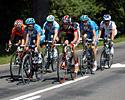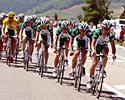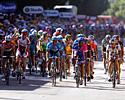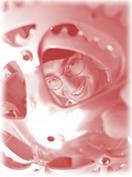
Recently on Cyclingnews.com |
View from the lab - Ric Stern's Tour de France sports science
|
|
British ABCC coach Ric Stern (www.cyclecoach.com) is a regular contributor to Cyclingnews' Form & Fitness section along with being a full time coach. Still an active rider when time allows, Ric will be providing a physiological insight into the challenges that face the riders in the Tour.
July 3, 2006: The break vs. the peloton
The first road stage of the 2006 Tour de France, and we have two different aspects of cycling going on: the long breakaway and the sprint finish.

|
As is usual with cycling and frequently the first day of the Tour, a long breakaway dominated the action. A group of seven soon formed, and it appeared that the peloton let them stay away. That is, the bunch allowed them some headway, and this helps to control the race. Thor Hushovd’s Credit Agricole team kept the break in check only letting them get a few minutes up the road, rather than letting them get many minutes up the road, as has happened in the past.
In the break, once an initial hard effort has been put in to separate the break from the peloton, the riders would have settled down to a nice rhythm. As they were away for a good length of time (around 3 hours) the actual effort they were putting in would have been moderate, it’s likely to have been on average around zone 2 to 3. During this effort, and especially in the heat it would have been critical to remain well hydrated and to consume enough carbohydrates.
Sports drinks are critical to help maintain fluid status, and carbohydrate levels. The main ingredients of most sports drinks are glucose and/or other carbohydrates, salts such as sodium chloride, calcium, magnesium and potassium, etc., and of course water. However, the most crucial ingredients of the sports drink are the glucose, the salt, and the water. The general recommendation is to consume ~ 30 – 60 grams of carbohydrate per hour, in a 4 – 8% solution. However, when it comes to using the drinks the most important aspect of the drink (or gel, or energy bar, etc) is the flavour. If it doesn't taste good, you're going to drink it, or eat it. It’s therefore, imperative to test drinks (etc) out in training, and not to leave it until race day (as you may find the flavour is unpalatable and you don't drink anything).
There's a multitude of commercial drinks available, so try several or more makes and see which flavour fits you best, and encourages you to drink frequently. You may, prefer one flavour from one manufacturer, and another flavour from another. Varying the flavours will stop you from getting bored with the taste, which could prevent you from drinking sufficient quantities.

|
Back to the race. As the seven breakaways were working cohesively together, they'd have all been sharing the workload on the front. This is important to share the workload. Although the seven would have only been riding moderately, they would still be fatiguing. Back in the main peloton, the workload would be shared by a much greater number of riders, thus allowing the peloton riders to be less tired, and fresher riders can come to the front towards the end. This enables the peloton to put its collective foot down towards the end of the stage and reel in the breakaways. The break on the other hand may not be able to lift the pace much in the final kilometres and they therefore get caught. Even cycling at a low intensity (~60 % VO2max) for just one hour can cause a significant decrease in top end aerobic power (5-minute TT) in well-trained cyclists (see Passfield, and Doust (2000), Medicine and Science in Sport and Exercise).
Once the break had been reeled in, it was down to the sprinters teams to set up a ‘train’ and drag the best sprinters to just short of the finish line. In the meantime, before the final sprint, George Hincapie took a great sprint to gain a few seconds and the maillot jaune. This is an important lesson for anyone riding a stage race – you need to be aware of these bonus seconds that can be on offer, especially if the final result is likely to be close.
With the peloton screaming down to the finish, the sprinters teams either made a mistake, or there were simply too many riders in the final. The sprint trains didn't seem well organised and, for example, Boonen was left to his own devices far too early. In your own training, in group rides with team mates you can practice leading out sprints and setting up your own train to deliver your team sprinter to the line – it isn't just about peak power (although it is hugely important) to get first over the line.

|
Not everyone can sprint well! Some riders actively prefer to be in a breakaway situation, so how would you train to be good for long breakaways? It’s not just about going out and doing long rides in zones 1, 2 and 3. In fact that may not be a very efficient way of doing things. While long rides are important (e.g., it gets you use to being on the bike for a long time, and weight management) and could well form a regular part of your training, it’s apparent that many riders just spend lots of time doing these rides and little else. By training at around, and just under ~1-hour time trial power/intensity for periods of 30 to 60-minutes, and at a slightly lower power (zone 3) for up to 2 hours you can increase your lactate threshold, TTpower, and MAP, and thus extend your endurance, and power at zones 2 and 3 (as well as higher zones).
If you have any queries on the physiology, etc. of the Tour de France, please email me on ric@cyclecoach.com and I’ll try to answer some questions.

